Snapchat charging brands for video ads viewed less than a second, according to buyers

Snapchat is charging advertisers for “zero-second video views,” according to industry insiders, who said the pricing system has brands worried that they’re paying for unseen ads.
Brands pay every time an ad loads, even if a user didn’t spend a full second with the video, according to a number of advertising sources with knowledge of Snapchat’s viewability standards.
“Snapchat is using this measurement that just seems off from what brands and clients want and where the rest of the industry is going,” said a digital marketing insider with direct knowledge of Snapchat’s ad model. “If an ad is on the screen for less than a second, it’s hard to imagine it made an impression.”
Snapchat has been selling video ads for less than a year, and many of its products are still in the early stages of development. Brands like Universal Pictures, Coca-Cola, Victoria’s Secret, and a number of others have been lining up to advertise to the app’s young audience, and some of them are repeat sponsors.
Snapchat does promote the fact that its videos take up the entire screen, leaving nowhere else for a user’s eyes to wander. It also pioneered the vertical video format that it says leads to higher viewing rates, because users don’t have to turn their phones for the ads to take up the whole screen.
Ads can appear in two places — on Discover channels, run by media partners like Vice, The Daily Mail and ESPN, or within Live Stories, which feature video montages around special events and locations. As users view the content, they can tap the screen to skip ahead to the next clip, and they can tap to skip ads.
In May, Snapchat announced it would charge advertisers 2 cents a view, but there had been some uncertainty over what constituted a proper view. At the time, Snapchat did tell Ad Age that views would register after milliseconds.
However, a number of ad buyers were surprised to discover just recently that campaign results were being based on these “zero-second” view counts, the sources familiar with the pricing said.
“Snapchat charges for views even at zero seconds,” said a source, who is close to a top telecom brand that has bought ads on Snapchat. “The brands didn’t even realize this was happening. It’s all fairly new, and everyone’s just starting to recognize what’s going on.”
Rival platforms have higher standards. Twitter, for instance, says it only charges for video ads that are 100 percent on screen for at least three seconds. Facebook has a three-second rule, but the videos only need to be 50 percent on screen.
Advertisers have been demanding more accountability from platforms, in general. They are asking for independent verification of view counts and higher thresholds of viewability.
“We are always looking to make improvements so that we can drive even more value for our customers,” a Snapchat spokesperson said in a statement.
The ad pricing does take skip rates into account, a source close to the company said. For instance, advertisers aren’t charged when users skip an ad before it even loads. Snapchat made all ads skippable because it believes that leads to a better user experience, and brands benefit from being less intrusive.
Also, Snapchat works with third parties to measure the impact of ads, and has so far seen positive results in awareness and other brand-focused metrics, according to the case studies.
Every second of digital video is precious for brands trying to capture the attention of fast-moving fingers that can quickly scroll past their content. So, advertisers take their fleeting time with consumers very seriously on all digital platforms; even a second of screen time can be a positive impression.
One digital agency executive said Snapchat could eventually embrace a tighter definition of viewability.
“Users could bail before seeing the ad, which will always raise some concerns for buyers,” the agency exec said. “I wouldn’t be surprised to see some movement on this front from them in time.”
More in Media

A timeline of the major deals between publishers and AI tech companies in 2025
Here’s a list of all the major deals signed between publishers and AI tech companies in 2025.

No playbook, just pressure: Publishers eye the rise of agentic browsers
For the bulk of publishers, Google is, as ever, the one to watch. It’s already got agentic features within its Chrome browser, but that’s the tip of the iceberg, some say.

The biggest SEO lessons in 2025 for publishers
KPIs are changing, more AI search data is becoming available, and publishers are looking beyond search to grow their audiences and revenue.





